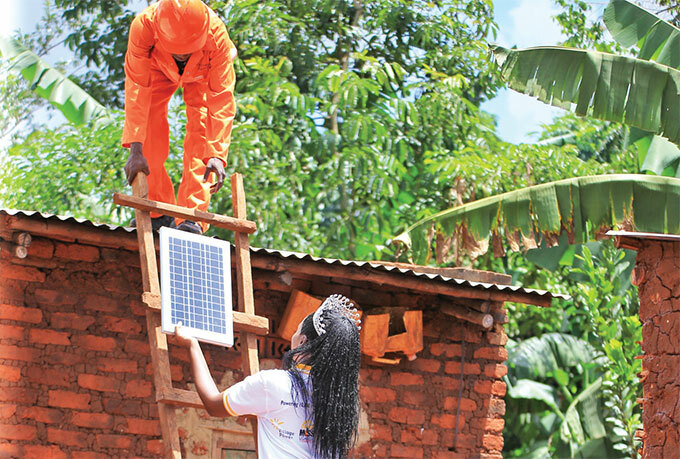Off-grid solar systems put out 265,000 'tadoobas'
The use of renewable energy has been gaining grip over the years as the demand for electricity soars.
INFRASTRUCTURE
Huge investments by 23 solar firms have freed thousands of households in Uganda's rural areas from using tadooba, a tin kerosene lamp commonly used as a source of lighting, according to a survey.
Findings from a report by the Uganda Solar Energy Association (USEA), released recently, indicated that nearly 313,424 off-grid solar systems were sold in 2018, with about 115,213 products sold in the first half of the year.
The findings also show that most of the buyers of solar products preferred to pay using Pay As You Go (PAYGo) products as compared to cash.
"The number of solar sales translates into 265,000 kerosene lamps being replaced by off-grid solar products," the report reads. PAYGo is a service by solar firms, which enables low income earners to purchase a product through making small instalments as compared to making a lumpsum.
The use of renewable energy has been gaining grip over the years as the demand for electricity soars.
The annual sales and impact data pilot survey conducted by USEA covers off-grid product purchases between January to December 2018. It was conducted among 23-member solar firms under USEA, which comprises manufacturers, assemblers and distributors.
Most solar clients, according to the findings, also opted for multi-light systems, with purchases increasing from 39.7% to 53%. The largest quantities of solar products were sold in the central region (118,830 products), followed by eastern region (68,857), western region (66,054) and northern region (59,683).

Former Miss Uganda, Quiin Abenakyo helps a technician to install a solar system in a home in Mayuge district
According to the report, the total solar purchase contributed about 8.18MW of newly installed electricity capacity. "
Only a complete system comprising both power generation (the solar panel) and its storage (the battery) were considered in this pilot, as they ensure households of a certain level of access to modern energy that is significant enough to contribute to Uganda's universal electrification goal," USEA's chief executive officer, Joyce Nkuyahaga, said in a statement.
Sales of components, such as single panels or single batteries, accessories, including mobile chargers, solar-powered appliances (TV, fans, irrigation systems) were not included in the scope of this pilot.
Growth of off-grid Only about 8% of the rural communities have access to electricity, according to the Rural Electrification Agency (REA), a government body mandated to extend electricity to the rural poor.
The use of solar products has been growing steadily over the past five years. In the rural setting, dependence on the grid is unreliable. They are often faced with constant load-shedding either due to weather interferences or vandalism of electricity equipment.
Additionally, people in rural areas are scattered. Therefore, wiring them to the grid is not economically viable, according to government officials, making off-grid products a fitting alternative.
However, the major cost element for solar power has been the installation costs and the upfront fees a client is required to make before they are connected. Many rural households see these costs as a major constraint to purchasing off-grid products. But the improvement in technologies, coupled with subsidies from Government, has led to a relative fall in prices in the recent past.
Many local and international companies in the off-grid solar sector have heavily invested in emerging technologies to further boost access. REA, in partnership with these firms, targets to increase rural electricity access to 26% by 2022, through a mix of grid and off-grid solutions.
"The impact generated by these sales is highly significant, both for households and the environment. As a result of the sales, this report estimates that 1.3 million people benefitted from improved energy access in 2018. Many customers are also using their off-grid solar products to extend their working day or to support their business activities," Nkuyahaga.
She added: "In 2018, about 97,000 people undertook more economic activity as a result of purchasing off-grid solar products. Given the lifespan of the products sold, on an average of a two to four-year period, this economic activity could help customers generate over $50m in additional income."
The growing uptake of off-grid solar systems directly translates into more households being able to light their homes or businesses, charge their mobile phones or use appliances, such as TVs, fans and fridges, according to Nkuyahaga.
Investments in solar The Government scrapped Value Added Tax on solar batteries and lanterns to further boost solar power uptake this financial year.
In 2018, Fenix International, an off-grid energy company, committed to injecting over $150m (sh550b) in off-grid solar products, an investment that could partly explain the jump in sales.
In an interview with New Vision, Lyndsay Handler, the chief executive officer of Fenix, said: "We chose Uganda after a review and analysis of multiple locations across the continent, including several other countries in the East Africa region. "Uganda's inspiring 2030 vision focuses around the transformative power of new technologies and business development.
We want to show the world that Uganda is a place to invest," she added. In 2017, M-Kopa secured $80m to finance access to solar energy in about a million homes in Kenya and Uganda. M-Kopa's partnership with a group of lenders, including Stanbic Bank, was arguably the largest credit commitment towards off-grid solar energy in East Africa.
The World Bank projects that these interventions will push the electrification rate in Uganda to about 40%. Although Uganda has invested massively in power generation, the challenge facing Government now is striking a balance between generation and transmission.
It is estimated that Uganda needs about sh20 trillion to evacuate the surplus electricity that the Government plans to generate in the next 20 years.